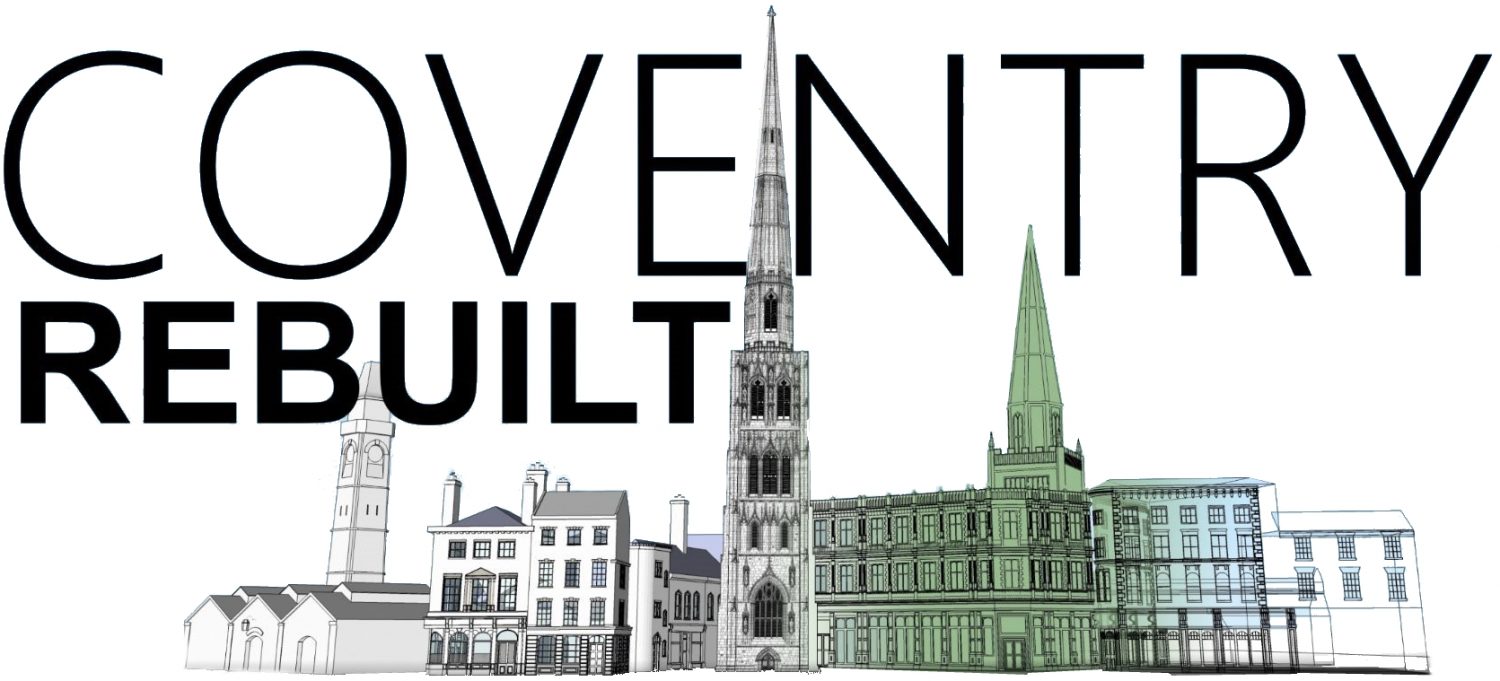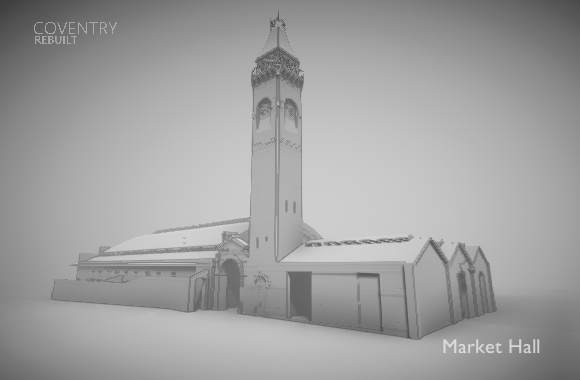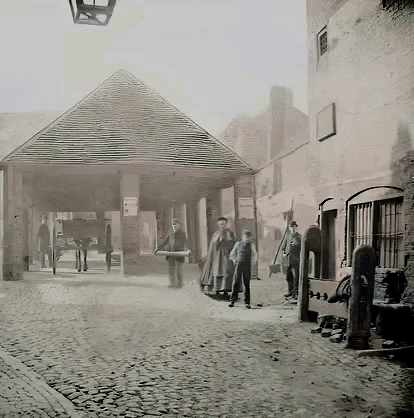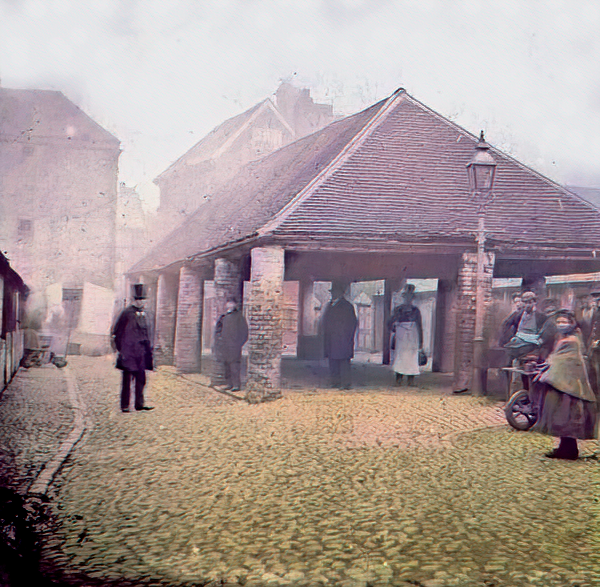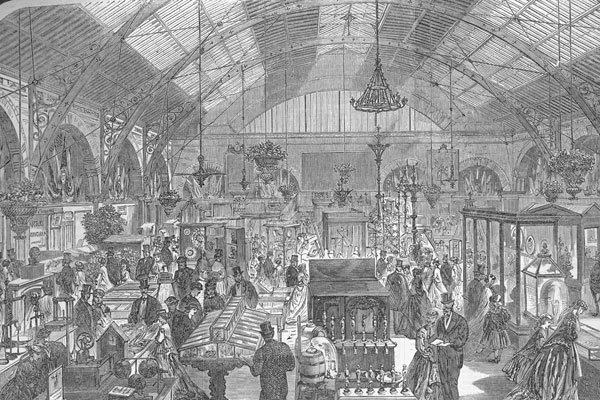Market Hall & Clock Tower
1719
The ‘old’ Market Hall was a relatively small structure situated to the West of Broadgate, between West Orchards and Smithford Street. Built in the yard of the Peacock’s Inn, in 1719. It was known by some as Solomon’s Temple – apparently named after one of the custodians of the Market building. However important this market building was, the main market was the open air market in Broadgate.
1863
Alderman H Soden –
“The state of Broadgate on Market Days was a disgrace to the city – positively uncivilised!
It had been decided some time ago that the crockery dealers should be restricted to Market Street and the fish sellers to another part.
But lately the crockery dealers have found their way back to the centre of the town and are making a great nuisance of themselves!”
20th August – Queen Victoria gives Royal Assent to the building of the Coventry Market Hall via the Coventry Market Hall Act 1863
December – The Corporation reports the cost is between £5,000 – £10,000 for the buildings, about £6,000 for the land but that excludes the property already owned by the Corporation. The Clerk then reports a figure of £25,000 to £30,000 for the whole project. [Sounds like he was making it up on the spot!].
January – An exhibition at St Mary’s Hall of several designs, each comprising of 7-8 drawings. They were all well received by the Corporation and the people of Coventry.
However, the winning design was modified by the Corporation to allow for a Crystal Palace style roof from the second best design. The site chosen will remove a number of old buildings that a strange to the city would hardly believe could exist in the centre of a respectable old place like Coventry.
The primary entrance to the Market Hall will be from West Orchards that will include a row of high-quality shops. The second entrance will be via Market Street. The entrance from Broadgate will be widened with the removal of the City Arms Inn. In all, this will be a marked improvement and benefit to public sanitation.
The ornamental tower, adapted from the fixing of a clock was taken from the winning design was not to be erected immediately due to cost. It may, however, be added with advantage at a future period when the town is more prosperous. It has been proposed that a time ball might be added to its extreme summit instead of the customary wind vane – the watchmakers of the city would see this as a great advantage to be in immediate communication with Greenwich.
September – A suggestion of a ceremony and dinner to mark the laying of the foundation stone was put forward. The motion was not carried and so, never too place.
Contract awarded to Mr W Tomlinson of Coundon – Between 1865 and 1867 the demolition and building work takes place.
Grand Opening
Wednesday 19th June 1867
The Coventry and Midland Manufacturing, Industrial and Art Exhibition
Local Societies & Associations are invited to take part in a procession on the opening day.
Notice to exhibitors – no goods will be received after 10th June.
Season tickets (including admission on the opening day) will be ready on and after Monday next.
They will be on sale at the Herald Office & Corn Exchange – Adults 15s, Children 7s 6d.
Two enormous lumps of Coal from Wyken Colliery – each weighing up to two Tons will be standing against the exits.
Numerous models of buildings.
Interesting displays of natural products of minerals and fossils.
A quantity of old armour and guns from Coombe Abbey.
300 Pictures on loan from the Earl of Craven, Earl of Dudley, Earl of Warwick, Lord Leigh, Mr Bromley MP, Mr Wise MP and some treaures from Dr Dewes and Mr Gulson. Rev J W Leigh has provided a selection of water colour drawings. Mr Eaton MP specimens of Alhambra decoration taken from the Alhambra Palace.
Ancient Corporation records will be arranged in cases down the centre.
Valuable assortment of antiquities from Lichfield museum will be on display.
The celebrated Kenilworth Buffett of carved oak will be on display, which formed an attractive object in the great exhibition of 1851 and was afterwards purchased by the inhabitants of Warwick and presented by them to the Earl of Warwick on his marriage. [ The buffet has not moved from Warwick Castle – click here ]
Every Day – the fair fountain will be flowing, pipping Bullfinches & Machinery in Motion, Doors open at 10 o’clock and close at dusk.
The Exhibition will be open every Saturday afternoon after 2pm for the WORKING CLASS at six pence each.
[To the musical profession – a gentlemen required to act as organist and pianist at the Coventry Exhibition, also six instrumentalists for the quadrille band – apply at the market hall]
- Right Honourable Lord Leigh
- Lord Lieutenant of Warwickshire
- The Right Honourable the Earl of Clarendon
- K.G. James Marriott
- Esq Mayor of Coventry
- The Right Rev. the Lord Bishop of Worcester
- The Right Honourable Lord Lyttelton
- Lord Lieutenant of Worcester
- The Right Honourable the Earl of Aylesford
- The Right Honourable Earl Howe
- The Mayors of Tamworth, Lichfield, Nottingham, Derby and Stratford, Captain Adams
- Rev. J.H.Iles (Wolverhampton)
- Rev. R.H. Baynes (Coventry)
- Rev. S.H Wilddrington
- Rev. Dr Temple, Rev. A.W. Wilson (Coventry)
- Rev. E.E. Delf (Coventry)
July – Shilling days – Monday, Tuesdays Wednesdays, Thursdays, Fridays and Saturdays. Half Crown Days – Thursdays. Children Half Price, Season Tickets down to 10s.
August – ‘Everyone should read Mrs Brown’s Trip to the Exhibition at Coventry priced at two pence published by Mr W. Fred of Taunton’.
Exhibition Prize Medal – The committee of the Coventry Exhibition hereby offer a prize of £5 for the best design for a medal to be given o the successful exhibitors.
1st November – Starnurer Howkin – DRUNK and DISORDERLY! in Market Street – The prisoner pleaded guilty and expressed his regret for the offence. The bench discharged him with a fine of 2s 6d in the poor box.
20th November – The letting of Market Hall Shops and pitches will start at 12 o’clock promptly. The sale of ale, porter, wines or spirits will not be permitted in any part of the market hall.
2nd December – Market Traders OUTRAGE! They are now paying four times the rents they did in Broadgate. They make a request o the Mayor and Aldermen that they can trade each of the first five evenings of the month until 8 pm with the use of free gas light.
Saturday 30th November 1867
Last Open Air Market in Broadgate
Under the Coventry Market Hall Act 1863 – Any person other than a licensed hawker, who sell’s or exposes for sale in any pace in this city expect his own dwelling place or shop will be liable to be a penalty not exceeding forty shillings.
This will come into effect on Monday 2nd December 1867.
July – Property on Broadgate bought by the Corporation to be demolished to make a wide access to the Market.
November – The roof of the market hall is leaking. The market committee say they have painted it as best they can but can never guarantee that it will never be watertight.
September – Mr Kemp’s celebrated Hal Green Cabbage Plants available at Coventry Market Hall on Friday 21st and the following two Fridays. Orders left at the White horse will be punctually attended to.
The Market Hall is struggling to make any money, with most of it empty. The Corporation suggests moving the Butcher’s from Butcher’s Row into the Market Hall. Another suggestion was to mothball the main hall and only use the outdoor area and the minor hall. Neither idea are carried out.
[A white elephant in the making?]
1870
Tower & Clock Opened to the Public
Mr E T Loseby won the contract for the clock and was awarded £308 10s but owing to Mr Losbey’s desire to make the clock as perfect as possible, it is believed to have cost him in the region of £600.
A clause in the contract – for every second the clock varied over 1 second the winner of the contract would forfeit £1. The clock was to be wound once per week. The clock was finsihed by June 1870.
[Years later the clock was described as the second best public clock mechanism in the UK, second only to that of Big Ben]
October – Billingsgate language that is begin used by the fish stalls is untenable! can anything be done to abate this nuisance?
11th June – The Coventry Midlands Fancier’s Society – first annual meeting show of pointing and other dogs. Schedule of prizes can be obtained from Mr J W Mills 73 Little Park Street. Entries to be made by 25th May 1879.
June – Post of custodian of the Market Clock – responsible for winding and regulating the clock, salary of £10 per annum. terminable by three months notice on either side.
19th November – A group of men watched the clock awaiting the electrical signal from Greenwich, so that watches could be compared and if need be rectified. Mr Samuel Corbett of Smithford Street is in charge of the clock – along with many clocks in the Coventry area for factories and mansions. 85 steps to the clock and a further 30 to the roof where the bell is located which strikes on the hour. The summit of the tower also carries the wires which are connected to the time signal from far below.
The maker E.T. Loseby of Leicester was born in 1817, a son of a clockmaker. Bullet holes observed in the clock face – the crack from them is monitored with dates recorded next to marks – the first is 31st May 1912. The latest was recorded as the 6th June 1914 which reached the rim and is now turning back on itself. [Who knows why the didn’t like the clock to shoot it?]
Four gas lamps make the clock face visible which are lite automatically at 6:30 pm. The clock tower is 100ft high, diameter 5ft wide, numbers are 91/2 inches, minutes are 1 1/2 inches, minutes 2ft 10 1/2 inches with a breath of swell of 5 inches and an hour hand 2ft 1/2 inches long with a breath of swell 5 1/2 inches. The bell is 10 cwt and is struck by two hammers alternatively 25 lbs each with a fall of 5 inches. The weight driving the striking part is 450 lbs and the hand motion weight is 150 lbs. Each of the large weights has a clear feet of 40 feet in eight days.
1916
“The Magistrate expressed the opinion that the Market Hall should make better protection against small boys!”
August – Four boys aged nine to eleven were brought before the magistrates charged with Larceny. Arthur Edgar Longbottom (Aged 10, 6 Bully Yard), Peter Hogan (Aged 10, 17 Greyfriar’s Lane), William Ball (Aged 9, 34 Warwick Lane), Joseph Ball (Aged 9 Greyfriary’s Lane) all scholars of Chyelsmore school.
Accused of stealing twenty-seven pocket knives, three sets of feeler gauges – the property of Edward Norton an ironmonger who has a stall in the Market Hall. Along with ten shillings worth of chocolate belonging to Thomas Herbert Glenn who also has a stall in the Market.
The spikes on the bottom of the arcade were forded away between Thursday evening and Friday morning. The boys all pleaded guilty. The parents of the boys had acted very well and took every precaution to see that their boys told the truth.
The boys had hidden the items in a partly demolished house in Greyfriars Lane, where they had been playing. The defendants were bound over the probation of offenders Act to be of good behaviour for twelve months.
